In this week's Dig Through Time, let's examine a block from very early on in Magic's history, Tempest block. Tempest came out from 1997-1998, and is comprised of Tempest, Stronghold, and Exodus. For all of you Vorthos out there, this block is set on the plane of Rath, which has since become fused with Dominaria.
Magic's early blocks covered just two keyworded mechanics, and Tempest's were buyback, which allows you to put a spell back into your hand as it resolves by paying an additional cost, and shadow, which is essentially flying, except that shadow creatures can't block non-shadow creatures.
Tempest also introduced some new creatures to the game. Licids, slivers, and spikes all made their debut over the course of the block. Remaining popular to this day, slivers have returned a number of times, and it seems probable that we still haven't seen the last of them. Spikes may have been popular at the time (I really don't know? Were they good in Limited?), but with the exception of Spike WeaverSpike Weaver which saw a huge, well, spike in price shortly after Atraxa, Praetors' VoiceAtraxa, Praetors' Voice was printed, no one really plays them in any format today. Licids are extremely weird (but we'll get to that), and have essentially been completely forgotten. Today, I hope to reacquaint the EDH community with these strange little bugs. Without further ado, let's dig in.
Illicid Entertainment

Calming LicidCalming Licid is our first licid, and it sees play in 11 decks. Here's what you need to know about licids: similar to how the gods of Theros can gain or lose their creature status, licids have the ability to change their permanent type, from creature to enchantment aura, and back again. If someone attempts to blow up your Calming Licid with a MurderMurder, you can pay a white, tap it, and pop it onto your opponent's Drana, Liberator of MalakirDrana, Liberator of Malakir as an aura, and the Murder fizzles for lack of a valid target. If another player tries to get rid of the licid from Drana with a Forsake the WorldlyForsake the Worldly, you can pay a white to make the licid is a 2/2 creature again, and Forsake fizzles for lack of a valid target. Now, if a smart opponent is packing a Krosan GripKrosan Grip, and targets your licid-as-an-enchantment, you'd think that the little guy is sunk, since you can't respond to a spell with split second, but fear not! Turning a licid into a creature is a special action, just like playing a land or unmorphing a permanent, and does not use the stack, enabling you to turn it back into a creature, and fizzle the Krosan Grip. Something to note, though a licid can change back and forth between a creature and an enchantment aura, changing types does not make it a new object, so cards like Anguished UnmakingAnguished Unmaking and Utter EndUtter End can still track and remove it, regardless of whether it's changed from one type to another in response. Two additional points:
- Unlike bestow cards like Eidolon of Countless BattlesEidolon of Countless Battles, if the creature your licid is enchanting leaves the battlefield, your licid won't fall off and turn back into a creature. It is put into the graveyard as a state-based effect, since it is an aura that is not attached to anything. So, that means that board wipes can kill licids.
- Changing a licid's type back and forth doesn't give it summoning sickness, as long as it remains the same object (hasn't been flickered, etc.) and has been under your control since the beginning of your most recent turn (hasn't been stolen, etc.).

Kitsune MysticKitsune Mystic, an unofficial, not technically legal, commander, plays Calming Licid the most at three decks. This card is similar to Prison TermPrison Term or Cage of HandsCage of Hands, but a little bit more versatile, since you can potentially lock down a different creature during each opponent's turn. This card would be fine for an aura voltron-style deck helmed by someone like Sigarda, Host of HeronsSigarda, Host of Herons or Uril, the MiststalkerUril, the Miststalker, or for any deck that wants to try a little bit of unorthodox removal.
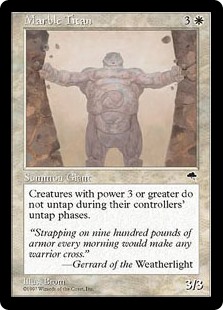
Marble TitanMarble Titan is a great piece of prison tech that sees play in just 147 decks. Any deck running guys with tiny power (or no guys at all) will love playing this guy to keep that Atarka, World RenderAtarka, World Render from misbehaving more than once. Creatures with native vigilance, like the ever-popular Sun TitanSun Titan, just shrug off Marble Titan's effect. Or you could just run cards like ReconnaissanceReconnaissance or Always WatchingAlways Watching to give your whole team vigilance. Defender tribal, Shadowborn ApostleShadowborn Apostles, small-power-matters, combo, and lockdown are all archetypes that could utilize Marble Titan.

Doran, the Siege TowerDoran, the Siege Tower plays this card the most at 46 decks. Ikra Shidiqi, the UsurperIkra Shidiqi, the Usurper and/or Sidar Kondo of JamuraaSidar Kondo of Jamuraa both capitalize on strategies that benefit from Marble Titan. Derevi, Empyrial TacticianDerevi, Empyrial Tactician doesn't mind Marble Titan's effect, since she can just untap whatever creatures she needs to attack during the next turn. Brago, King EternalBrago, King Eternal, Roon of the Hidden RealmRoon of the Hidden Realm, and other flicker and blink strategies can also work their way around Marble Titan's effect pretty easily.

Wall of NetsWall of Nets is a sort of repeatable Fiend HunterFiend Hunter/Banisher PriestBanisher Priest effect that sees play in 285 decks. This is another of those political Ghostly PrisonGhostly Prisons, a sort of defensive rattle snake that says "don't attack me, or else." If you find yourself in a faerie-populated country called December 25th, you might be able to pull off the incredibly janky move of equipping your Wall of Nets with a Darksteel PlateDarksteel Plate and enchanting it with EntanglerEntangler, while also landing a Gideon JuraGideon Jura; thereby forcing your opponents to surrender all of their creatures to exile.

Doran, the Siege TowerDoran, the Siege Tower plays Wall of Nets the most at 129 decks. Suggestions from EDHREC about how to build a deck with this card seem to imply that you should go all-in on wall building, but I don't think this card is limited to wall tribal. Some of the other suggested commanders for this card include Basandra, Battle SeraphBasandra, Battle Seraph, Numot, the DevastatorNumot, the Devastator, and Ayli, Eternal PilgrimAyli, Eternal Pilgrim. Each of those commanders supports a very different game plan, but still benefits from the defensive power Wall of Nets gives.
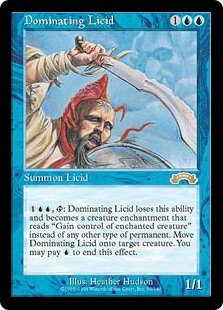
Dominating LicidDominating Licid is a unique, repeatable Control MagicControl Magic effect that sees play in 217 decks. Dominating Licid is one of the better theft effects, since you can change what you steal for four mana at a time. It's sort of like the pilfering version of Sakashima the ImpostorSakashima the Impostor or CryptoplasmCryptoplasm. If you like stealing the best thing on board at any given time, pick up a copy or three of this licid. Your opponents...won't thank you.
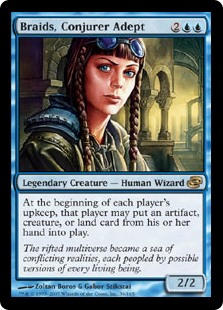
Braids, Conjurer AdeptBraids, Conjurer Adept plays Dominating Licid the most at 12 decks. I thought that sounded like a pretty interesting idea, and plugged Braids and the licid into EDHREC with the advanced filter. It looks like Braids decks that run Licid let everyone ramp out their stuff, and then steal and/or clone all of it. Seems fun. Most of the top suggested commanders center on stealing or cloning things, such as Lazav, Dimir MastermindLazav, Dimir Mastermind, Merieke Ri BeritMerieke Ri Berit, Thada Adel, AcquisitorThada Adel, Acquisitor, and Yasova DragonclawYasova Dragonclaw.
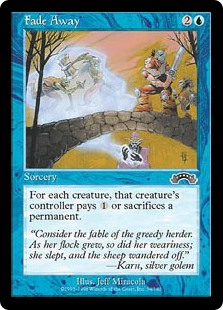
Fade AwayFade Away is a great "gotcha" that sees play in 131 decks. Opponents playing tokens, or even just tapping out to cast a couple of creatures, are going to be caught unawares, and find themselves forced to make some difficult decisions while watching their boards evaporate. I could see a version of my Kruphix, God of HorizonsKruphix, God of Horizons deck that runs all of 14 creatures playing this card. Even if I happen to have all 14 on board at once, I should be able to easily pay for Fade Away due to the Kruphix mana storage system, while my opponents likely won't be so lucky.

Narset, Enlightened MasterNarset, Enlightened Master plays this card the most at 23 decks. Any spell-slinging, or voltron-esque commander could probably run this card to good effect. Some of the other top suggestions are Melek, Izzet ParagonMelek, Izzet Paragon, Nekusar, the MindrazerNekusar, the Mindrazer, and Teferi, Temporal ArchmageTeferi, Temporal Archmage. Interestingly, Mizzix of the IzmagnusMizzix of the Izmagnus does not appear as a suggested commander. All you Mizzix players out there, that's just an oversight, right?

InterdictInterdict is yet another ability counter that sees play in 151 decks. If you read this column regularly, you know that I talk about a number of cards that interact with abilities including RerouteReroute and SquelchSquelch, so you may be wondering why I'm talking about this one. Interdict is unique in that it can shut down a permanent for a whole turn. You can stop decks from going off with Staff of DominationStaff of Domination, Oracle's VaultOracle's Vault, or Necrotic OozeNecrotic Ooze. Even just shutting down a value piece like Luminarch AscensionLuminarch Ascension, Sadistic HypnotistSadistic Hypnotist, or AttritionAttrition for a turn can be handy. And, like Squelch, Interdict lets you cantrip, making it almost strictly better.
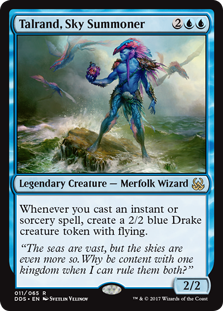
Stereotypically fueled by counterspells, Talrand, Sky SummonerTalrand, Sky Summoner plays this card the most at 55 decks. Interdict is a fine piece of good stuff for any deck running blue, though. Despite being played in only 151 decks, Interdict is spread out among 18 different top commanders, which is quite a swath. Throw it into Baral, Chief of ComplianceBaral, Chief of Compliance, Jori En, Ruin DiverJori En, Ruin Diver, or Jeleva, Nephalia's ScourgeJeleva, Nephalia's Scourge.

Corrupting LicidCorrupting Licid is a piece of unusual evasion that gets played in six decks. Not only does this card help your heavy-hitters get in for big beats, but you should never underestimate the ability to pop some evasion onto your opponent's creatures at instant speed. Corrupting Licid is as political a card as they come; especially if you play in a meta that runs lots of combat. Not only can you let your opponent's creatures get through for damage, you can trick opponents in to making bad trades. If, for example, you pop this licid onto an opponent's Saskia the UnyieldingSaskia the Unyielding and let them attack into a turned on Rhonas the IndomitableRhonas the Indomitable, thinking they're going for the kill, you can pop the licid off before the declare blockers step, allowing the Rhonas player to kill Saskia.
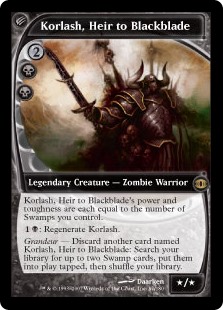
There are no top commanders for this card. I would think about running this in my Korlash, Heir to BlackbladeKorlash, Heir to Blackblade deck, or possibly Ishai, Ojutai DragonspeakerIshai, Ojutai Dragonspeaker+Ravos, SoultenderRavos, Soultender, as a way to get Ishai past fliers, and one that Ravos can keep putting in your hand. Any Bx deck that wants to get through for damage, like Karlov of the Ghost CouncilKarlov of the Ghost Council could make decent use of Corrupting Licid.

Death Pits of RathDeath Pits of Rath is another combat-oriented card that sees play in 288 decks. This card basically reads "all damage is dealt as though its source had deathtouch." And on top of that, it doesn't allow creatures dealt damage this way to regenerate, if that's ever relevant. This card makes chump blockers really good, making it ideal for token-spamming decks. First strikers also become a nightmare for your opponents to deal with when this card hits the battlefield, which makes Archetype of CourageArchetype of Courage an all star in any deck playing Death Pits.
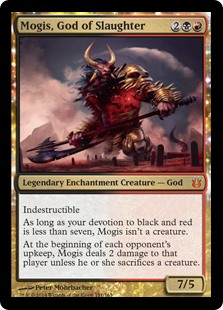
Tending to jam lots of nasty enchantments, Mogis, God of SlaughterMogis, God of Slaughter plays this card the most at 56 decks. Though I'm considering taking it out of my own build, since I run no creatures, it could work out in a deck that plays more guys. Other great commanders to play this card include Shirei, Shizo's CaretakerShirei, Shizo's Caretaker, Marrow-GnawerMarrow-Gnawer, and Athreos, God of PassageAthreos, God of Passage.

OnslaughtOnslaught is a now-out-of-color-pie enchantment that sees play in only 43 decks. This is a card I didn't know about prior to writing this article, and I absolutely love it. Onslaught takes away all your worries about your opponents' best blockers, so long as you have just a couple of creature cards in hand. The tapping also becomes permanent if you run it with Marble TitanMarble Titan or MeekstoneMeekstone, allowing you to maintain your incremental board advantage.
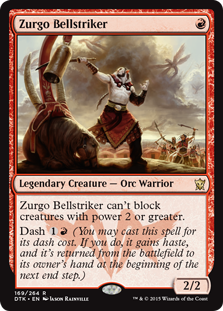
Zurgo BellstrikerZurgo Bellstriker plays this card the most at five decks. I know I'm going to pick up a copy for my paper Grenzo, Havoc RaiserGrenzo, Havoc Raiser deck. This card is fantastic in any mono-red aggro deck like Krenko, Mob BossKrenko, Mob Boss, or Urabrask the HiddenUrabrask the Hidden. I would also consider this for a Saskia the UnyieldingSaskia the Unyielding, or creature-based Prossh, Skyraider of KherProssh, Skyraider of Kher deck.
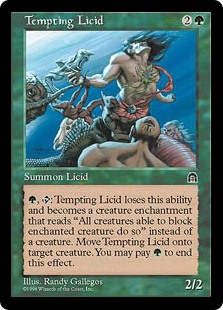
Tempting LicidTempting Licid is an incredible piece of combat tech that sees play in all of 76 decks. I have personally been on the receiving end of Tempting Licid thanks to my paper meta friend Oliver and his amazing, janky, elf-drazi Freyalise, Llanowar's FuryFreyalise, Llanowar's Fury deck. If any of your opponents run a deck that even remotely relies on combat damage to win a game, Tempting Licid is fully capable of ruining their day. This card takes out attackers and blockers without a care, forcing your opponents to make bad blocks and/or take bad blocks, and then popping off before combat damage. I already went over all of the unusual qualities of licids that make them hard to kill, but let me take this moment to reiterate: licids are incredibly difficult to kill. The table will feel like they're on a bug hunt trying to PutrefyPutrefy, DismemberDismember, and Sudden DeathSudden Death Tempting Licid off the table, but to no avail.

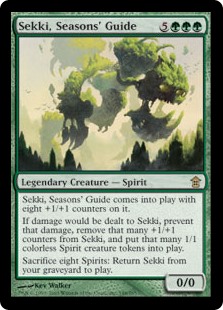
Marhault ElsdragonMarhault Elsdragon and Sekki, Seasons' GuideSekki, Seasons' Guide both play this card the most at 7 decks each. LureLure effects are seriously underrated in EDH. This is probably due to the fact that they're usually one-time use, or, like Nemesis MaskNemesis Mask only go on your own creatures. Tempting Licid sticks around, and goes on whatever you want. If you're playing a deck with lots of indestructible, first strike and/or deathtouch shenangians, then you have the option of putting it on your biggest threat, and if you're not, you can put it on your opponent's most fragile creatures that they really didn't want to trade with that crappy Spirit of the LabyrinthSpirit of the Labyrinth.
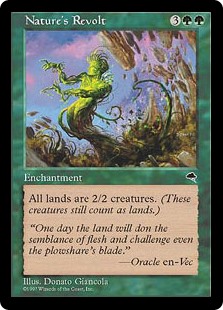
Nature's RevoltNature's Revolt is a permanent Natural AffinityNatural Affinity that sees play in 205 decks. Nature's Revolt heavily discourages boardwipes, which is something mono green sometimes has a problem recovering from, so it can help with that. If you like Living PlaneLiving Plane, but don't want to pay $150 for it...you might like this card. If you've always dreamed of stealing all lands with InsurrectionInsurrection and then killing their owners with said lands...you might like this card. If you're a fan of running Living PlaneLiving Plane or Kormus BellKormus Bell + Urborg, Tomb of YawgmothUrborg, Tomb of Yawgmoth with Elesh Norn, Grand CenobiteElesh Norn, Grand Cenobite...you might want to build in some combo redundancy with this card.

Of the 18 top commanders suggested by EDHREC, Karametra, God of HarvestsKarametra, God of Harvests plays this card the most at 19 decks. This card is an excellent addition to Titania, Protector of ArgothTitania, Protector of Argoth or The Gitrog MonsterThe Gitrog Monster, since it enables extra ways to cheat your lands into the graveyard. The next time you build a deck that cares about lands, consider some of the combos and options available to you with this card. And always remember to pack a Splendid ReclamationSplendid Reclamation, just in case.
The Action

For this week's action segment I built something a little extra janky. Inspired by Wall of Nets, I ended up building Wall tribal with Kynaios and Tiro of MeletisKynaios and Tiro of Meletis. The deck aims to stave off any aggro your opponents can throw at you, ramp big, and then cast and copy some giant X spells to kill your opponents in one fell swoop. Some of the cards I talked about this week play support, but Wall of Nets is the one that's most on-theme. I hope you enjoy, and I'll see you again in two weeks for another installment of Dig Through Time.
Kynaios and Tiro Build a Wall (and Make Your Opponents Pay for It)
View on ArchidektCommander (1)
- 1 Kynaios and Tiro of MeletisKynaios and Tiro of Meletis
Artifacts (4)
- 1 Sol RingSol Ring
- 1 Doubling CubeDoubling Cube
- 1 Chromatic LanternChromatic Lantern
- 1 Pyromancer's GogglesPyromancer's Goggles
Creatures (31)
- 1 Perimeter CaptainPerimeter Captain
- 1 Fog BankFog Bank
- 1 Jeskai BarricadeJeskai Barricade
- 1 Overgrown BattlementOvergrown Battlement
- 1 Stalwart Shield-BearersStalwart Shield-Bearers
- 1 Sylvan CaryatidSylvan Caryatid
- 1 Wall of BlossomsWall of Blossoms
- 1 Wall of MulchWall of Mulch
- 1 Wall of OmensWall of Omens
- 1 Calming LicidCalming Licid
- 1 Tempting LicidTempting Licid
- 1 Soulsworn JurySoulsworn Jury
- 1 Axebane GuardianAxebane Guardian
- 1 Bonded FetchBonded Fetch
- 1 Psychic MembranePsychic Membrane
- 1 Guard GomazoaGuard Gomazoa
- 1 Wall of NetsWall of Nets
- 1 Dominating LicidDominating Licid
- 1 Wall of DenialWall of Denial
- 1 Wall of FrostWall of Frost
- 1 Aether MembraneAether Membrane
- 1 PlumeveilPlumeveil
- 1 Marble TitanMarble Titan
- 1 Vent SentinelVent Sentinel
- 1 Nullmage ShepherdNullmage Shepherd
- 1 Mnemonic WallMnemonic Wall
- 1 Seedborn MuseSeedborn Muse
- 1 Kruphix, God of HorizonsKruphix, God of Horizons
- 1 Wort, the RaidmotherWort, the Raidmother
- 1 Melek, Izzet ParagonMelek, Izzet Paragon
- 1 Regal BehemothRegal Behemoth
Enchantments (6)
- 1 OnslaughtOnslaught
- 1 Storm FrontStorm Front
- 1 Cryptolith RiteCryptolith Rite
- 1 Mirari's WakeMirari's Wake
- 1 Mana ReflectionMana Reflection
- 1 Zendikar ResurgentZendikar Resurgent
Instants (10)
- 1 BrainstormBrainstorm
- 1 InterdictInterdict
- 1 Increasing VengeanceIncreasing Vengeance
- 1 Comet StormComet Storm
- 1 Fall of the TitansFall of the Titans
- 1 Render SilentRender Silent
- 1 MindswipeMindswipe
- 1 Sphinx's RevelationSphinx's Revelation
- 1 Wild RicochetWild Ricochet
- 1 Sylvan ReclamationSylvan Reclamation
Sorceries (11)
- 1 PreordainPreordain
- 1 PonderPonder
- 1 Collective VoyageCollective Voyage
- 1 VandalblastVandalblast
- 1 Red Sun's ZenithRed Sun's Zenith
- 1 Subterranean TremorsSubterranean Tremors
- 1 New FrontiersNew Frontiers
- 1 Fade AwayFade Away
- 1 Bonfire of the DamnedBonfire of the Damned
- 1 Clan DefianceClan Defiance
- 1 Tempt with DiscoveryTempt with Discovery
Lands (37)
- 4 ForestForest
- 4 MountainMountain
- 4 PlainsPlains
- 4 IslandIsland
- 1 Command TowerCommand Tower
- 1 Reliquary TowerReliquary Tower
- 1 Exotic OrchardExotic Orchard
- 1 Hallowed FountainHallowed Fountain
- 1 Stomping GroundStomping Ground
- 1 Breeding PoolBreeding Pool
- 1 Temple GardenTemple Garden
- 1 Sacred FoundrySacred Foundry
- 1 Steam VentsSteam Vents
- 1 Ash BarrensAsh Barrens
- 1 Wooded FoothillsWooded Foothills
- 1 Windswept HeathWindswept Heath
- 1 Flooded StrandFlooded Strand
- 1 Temple of the False GodTemple of the False God
- 1 Sunpetal GroveSunpetal Grove
- 1 Rootbound CragRootbound Crag
- 1 Glacial FortressGlacial Fortress
- 1 Misty RainforestMisty Rainforest
- 1 Arid MesaArid Mesa
- 1 Hinterland HarborHinterland Harbor
- 1 Boseiju, Who Shelters AllBoseiju, Who Shelters All
Dean Gootee
Dean is a father, writer, and long-time fan of Magic and gaming in general. Currently located in Rochester, NY; he loves playing with new people, so if you're ever in the area, shoot him a message. Follow him on Twitter @GrubFellow, where he tweets #dailyEDH microcontent.
Your opinions are welcome. We love hearing what you think about Magic! We ask that you are always respectful when commenting. Please keep in mind how your comments could be interpreted by others. Personal attacks on our writers or other commenters will not be tolerated. Your comments may be removed if your language could be interpreted as aggressive or disrespectful. You may also be banned from writing further comments.
